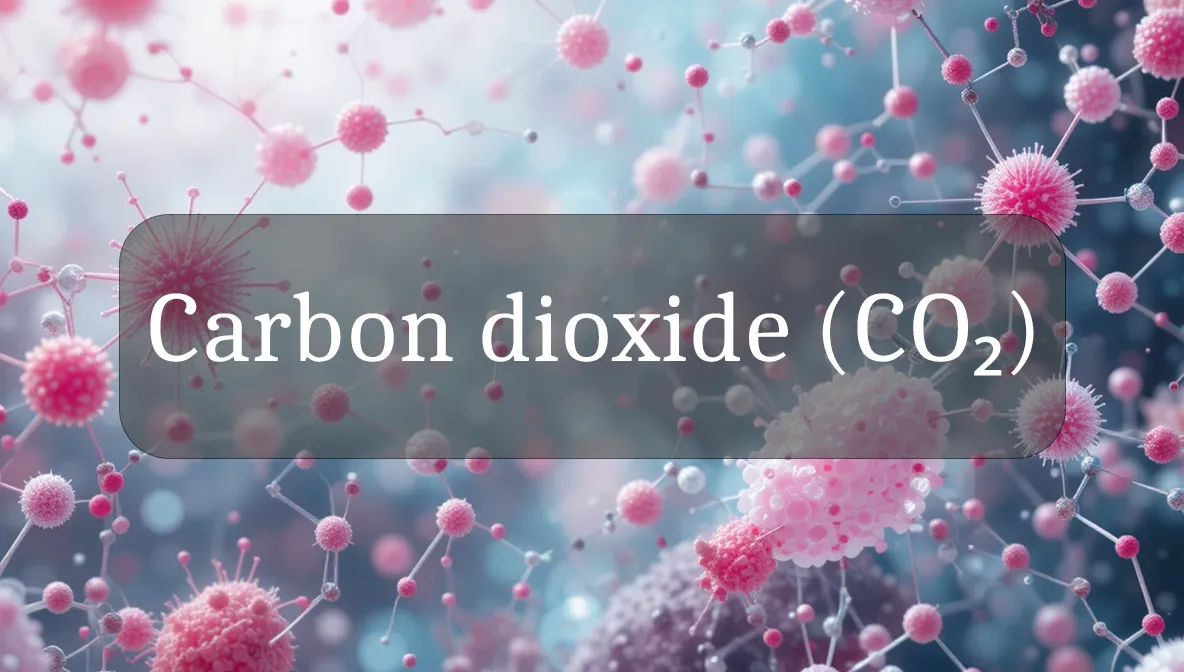Body’s Silent Regulator of Breathing and Balance
Carbon dioxide (CO₂) is like your body’s quiet rhythm keeper, a simple gas molecule that helps regulate breathing, blood flow, and acid-base balance. It’s a natural part of your daily wellness, ensuring your body stays oxygenated and balanced, though too much or too little can cause issues. Let’s explore what CO₂ is, how it supports your health, and practical ways to maintain its balance—all in a clear, friendly way to empower your wellness journey.
Chemical Identity and Type
Carbon dioxide (CO₂) is a small gas molecule composed of one carbon atom and two oxygen atoms. It’s a natural byproduct of your body’s energy production, formed when cells break down nutrients (like glucose) during metabolism. CO₂ travels through your blood, is exhaled through your lungs, and acts as a body signal to regulate breathing and maintain your blood’s pH balance. It’s not consumed directly but produced internally, with levels influenced by breathing, exercise, and diet.
Biological Role and Benefits
CO₂ is your body’s unsung hero, quietly supporting vital functions. Here’s how it helps your wellness:
- Breathing Regulation: CO₂ signals your brain to control breathing rate, ensuring your body gets enough oxygen to stay energized.
- Blood Flow Support: It helps dilate blood vessels, improving circulation and delivering oxygen to tissues like muscles and the brain.
- Acid-Base Balance: CO₂ combines with water to form carbonic acid, helping maintain your blood’s pH (around 7.4) for healthy cell function.
- Energy Production: As a byproduct of metabolism, CO₂ reflects efficient energy use, keeping you active and alert.
- Brain and Heart Health: Proper CO₂ levels support oxygen delivery to the brain and heart, boosting focus and stamina.
By maintaining these processes, CO₂ promotes energy, mental clarity, and overall vitality.
Dietary or Natural Sources
Your body produces CO₂ during metabolism, so it’s not a nutrient you consume. Instead, diet and lifestyle support the systems that manage CO₂ levels:
- Carbohydrate-Rich Foods: Whole grains, fruits, and vegetables (e.g., oats, bananas, broccoli) fuel metabolism, producing CO₂ naturally.
- Protein-Rich Foods: Eggs, chicken, and beans provide amino acids to support metabolic enzymes.
- Nutrient Boosters: Magnesium (spinach, almonds), B vitamins (eggs, whole grains), and iron (beef, lentils) support energy production and oxygen transport.
- Hydration: Water (8–10 cups daily) helps CO₂ transport and pH balance in the blood.
- Antioxidant Foods: Berries and leafy greens protect cells involved in CO₂ regulation.
No CO₂ supplements exist, as it’s a metabolic byproduct. Focus on a balanced diet to support metabolism and lung health.
Signs of Imbalance or Dysfunction
CO₂ imbalance, from too much (hypercapnia) or too little (hypocapnia), can disrupt health. Signs include:
- High CO₂ (Hypercapnia):
- Shortness of breath or rapid breathing.
- Drowsiness, confusion, or fatigue.
- Headaches or dizziness.
- Flushing or warm skin.
- Low CO₂ (Hypocapnia):
- Lightheadedness or tingling in hands/feet (often from hyperventilation).
- Muscle cramps or spasms.
- Anxiety or panic sensations.
- Fatigue or difficulty focusing.
High CO₂ may stem from lung conditions (e.g., COPD), slow breathing, or poor ventilation. Low CO₂ is often caused by stress, overbreathing, or metabolic issues. Both require medical attention if persistent.
Supporting Optimal Levels or Function
To keep CO₂ levels balanced and maintain its benefits, try these practical steps:
- Practice Healthy Breathing: Use slow, deep breathing (e.g., diaphragmatic breathing) to regulate CO₂ levels and avoid hyperventilation.
- Eat a Balanced Diet: Include carbs (quinoa, sweet potatoes), proteins (fish, lentils), and magnesium-rich foods (nuts, greens) to support metabolism.
- Stay Active: Moderate exercise like walking or yoga (3–5 times weekly) enhances lung function and CO₂ regulation.
- Get Enough Sleep: Aim for 7–9 hours to support respiratory and metabolic balance.
- Manage Stress: Stress can cause overbreathing, lowering CO₂; try meditation or mindfulness to stay calm.
- Stay Hydrated: Drink 8–10 cups of water daily to aid CO₂ transport and pH balance.
- Avoid Environmental CO₂: Ensure good ventilation in enclosed spaces to prevent CO₂ buildup from external sources.
Safety, Interactions, and Precautions
CO₂ is naturally produced and safe when balanced, but consider these points:
- Toxicity Risk: High environmental CO₂ (e.g., in poorly ventilated spaces) can cause drowsiness or confusion; ensure fresh air in homes or workplaces.
- Medical Conditions: Lung diseases (e.g., asthma, COPD) or kidney disorders can disrupt CO₂ balance, requiring medical care.
- Medications: Drugs like sedatives or diuretics may affect breathing or pH balance; consult your doctor if on these treatments.
- Hyperventilation: Stress or anxiety can lower CO₂ levels, causing dizziness; practice slow breathing to restore balance.
- Supplements: No direct CO₂ supplements exist, but magnesium (200–400 mg daily) supports metabolism and may aid CO₂ regulation.
Prioritize healthy breathing and lifestyle to maintain CO₂ balance naturally.
Fun Fact
Did you know CO₂ is why you feel the urge to breathe? Your brain senses rising CO₂ levels in your blood, not low oxygen, to trigger each breath—talk about a built-in alarm system!
Citations
- National Institutes of Health. (2023). Carbon dioxide and respiratory health. MedlinePlus.
- Mayo Clinic. (2024). Nutrition for metabolic and lung health.
- Cleveland Clinic. (2022). The role of carbon dioxide in acid-base balance.
- World Health Organization. (2020). Nutrient requirements for health.
- American Lung Association. (2023). Respiratory physiology and CO₂ regulation.

